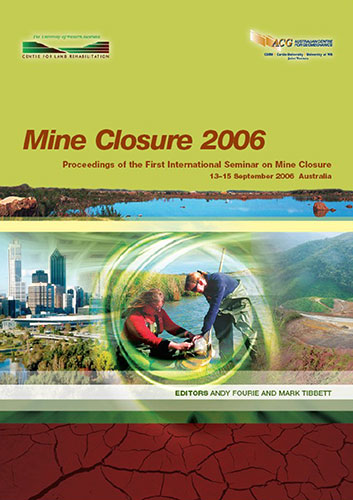An Assessment of the Direct Revegetation Strategy on the Tailings Storage Facility at Kidston Gold Mine, North Queensland, Australia

|
Authors: Mulligan, DR; Gillespie, MJ; Gravina, AJ; Currey, NA |
DOI https://doi.org/10.36487/ACG_repo/605_30
Cite As:
Mulligan, DR, Gillespie, MJ, Gravina, AJ & Currey, NA 2006, 'An Assessment of the Direct Revegetation Strategy on the Tailings Storage Facility at Kidston Gold Mine, North Queensland, Australia', in AB Fourie & M Tibbett (eds), Mine Closure 2006: Proceedings of the First International Seminar on Mine Closure, Australian Centre for Geomechanics, Perth, pp. 371-381, https://doi.org/10.36487/ACG_repo/605_30
Abstract:
A closure objective of Kidston Gold Mines Limited was to return a self-sustaining savannah woodland vegetation of native trees and introduced and native ground cover species to areas disturbed by its Kidston mining operation. One of the major areas of disturbance was the 310 ha tailings storage facility (TSF) into which approximately 68 Mt of tailings were deposited between 1985 and 1996. Early revegetation trials conducted in the early-mid 1990s demonstrated the capacity of the tailings to support vegetation growth without the requirement for a capping layer of soil or other cover material. The tailings storage facility was decommissioned at the end of 1997 and as the accessible area on the surface of the facility became progressively available (from March 1998 through to December 2001), planting and seeding of over 50 native tree and shrub species and 8 introduced and native pasture species was undertaken. With the support of drip irrigation over the first few months and initial fertilisation, the alkaline tailings have proven to successfully support the establishment and growth of a range of native tree and shrub species. Greatest success with upper-and mid-storey species has been where competition from introduced grasses has been minimised. Since 2001, up to four areas of different aged rehabilitation across the surface of the TSF have been monitored on an annual or biennial basis by The University of Queensland's Centre for Mined Land Rehabilitation (CMLR). The overall aim of the Kidston monitoring program has been to assess the progressive development, functioning and composition of the rehabilitation areas prior to relinquishment by the company. This paper presents some background on rehabilitation works and research trials undertaken on the tailings and reports on the most recent findings from the vegetation monitoring that has been conducted on the four TSF sites (TD40, TDNA, TDNB and CTD) in the period 2001 to 2005. The 2005 findings are presented in relation to two unmined analogue communities and preliminary rehabilitation targets. Monitoring against these interim targets has proven to be a valuable process for tracking the structural and functional development of these vegetation communities. In addition, an ongoing assessment of the tailings attributes contributes to our understanding of soil development processes and hence the longer–term sustainability of the reconstructed ecosystem as the company aims towards lease relinquishment.
References:
Bellairs, S.M. and Gravina, A.J. (2000) Landscape Function Analysis assessment of rehabilitation at the Kidston
Minesite, Report to Kidston Gold Mines Ltd, Centre for Mined Land Rehabilitation, The University of
Queensland.
Bowen, D. (2001) Rehabilitation monitoring manual: Methods for the assessment of rehabilitation and criteria for
determining rehabilitation success at Kidston gold mine, Report to Kidston Gold Mines Ltd, Centre for Mined
Land Rehabilitation, The University of Queensland.
Bruce, S.L., Noller, B.N., Grigg, A.H., Mullen, B.F., Mulligan, D.R., Marshall, I., Moore, M.R., Olszowy, H., O'Brien,
G., Dreyer, M.L., Zhou, J.X., Ritchie, P.J., Currey, N.A., Eaglen, P.L., Bell, L.C. and Ng, J.C. (2001) Targeted
research on the impact of arsenic and lead from mine tailings to develop quantitative indicators for mine closure.
Back to the Future: 26th Annual Minerals Council of Australia Environmental Workshop, Minerals Council of
Australia, Canberra, pp. 1-18.
Grundy, M.J. and Bryde, N.J. (1989) Land Resources of the Einasleigh - Atherton dry tropics, Queensland Department
of Primary Industries, QO89004.
Gutteridge, Haskins and Davey Pty Ltd (1982) Kidston Project, Impact Assessment Report, May 1982.
Krebs, C.J. (1985) Ecology: the experimental analysis of distribution and abundance (3rd edition), Harper and Row,
New York.
Neldner, V.J. (1993) Vegetation survey and Mapping in Queensland, Queensland Department of Primary Industries
Botany Bulletin No.12.
Perry, R. A. and Lazarides, M. (1964) Vegetation of the Leichhardt- Gilbert area, CSIRO Land Resource Series No 11.
Roseby, S.J., Mulligan, D.R., Menzies, N.W., Richie, P.J. and Currey, N.A. (1998) Ecosystem development on tailings
at Kidston Gold Mine, North Queensland, Australia. Land Reclamation: Achieving Sustainable Benefits, H.R.
Fox, H.M. Moore and A.D. McIntosh (eds), Balkema, Rotterdam, pp. 137-142.
Sanidad, W.B., So, H.B., Mulligan, D.R., Yatapanage, K., Horn, C.P., Currey, N.A. and Ritchie, P.J. (2000) The
importance of water use characteristics of native vegetation in the rehabilitation of a tailings dam: a case study at
Kidston Gold Mine. Remade Lands 2000 International Conference on the Remediation and Management of
Degraded Lands, A. Brion and R.W. Bell (eds), Promaco Conventions Pty Ltd, Perth, pp. 77-78.
Tongway, D.J. and Hindley, N. (1995) Manual for soil condition assessment of tropical grasslands, CSIRO Division of
Wildlife and Ecology, Canberra.
Tredwell, D.P., Grigg, A.H. and Page, M. (2003) Comparison of LFA and empirical measures of ecosystem function: a
case study from Kidston gold mine, Queensland, Northern Territory Minerals Council Workshop, Darwin, 10 p.
Williams, D.J., Mulligan, D.R. and Currey, N.A. (2006) A reflection and analysis of the waste rock dump closure
strategies at Kidston gold mine, First International Seminar on Mine Closure, Perth, Western Australia.
Ecosystem Reconstruction and Pedogenesis
Mine Closure 2006, Perth, Australia 381
© Copyright 2025, Australian Centre for Geomechanics (ACG), The University of Western Australia. All rights reserved.
View copyright/legal information
Please direct any queries or error reports to repository-acg@uwa.edu.au
View copyright/legal information
Please direct any queries or error reports to repository-acg@uwa.edu.au